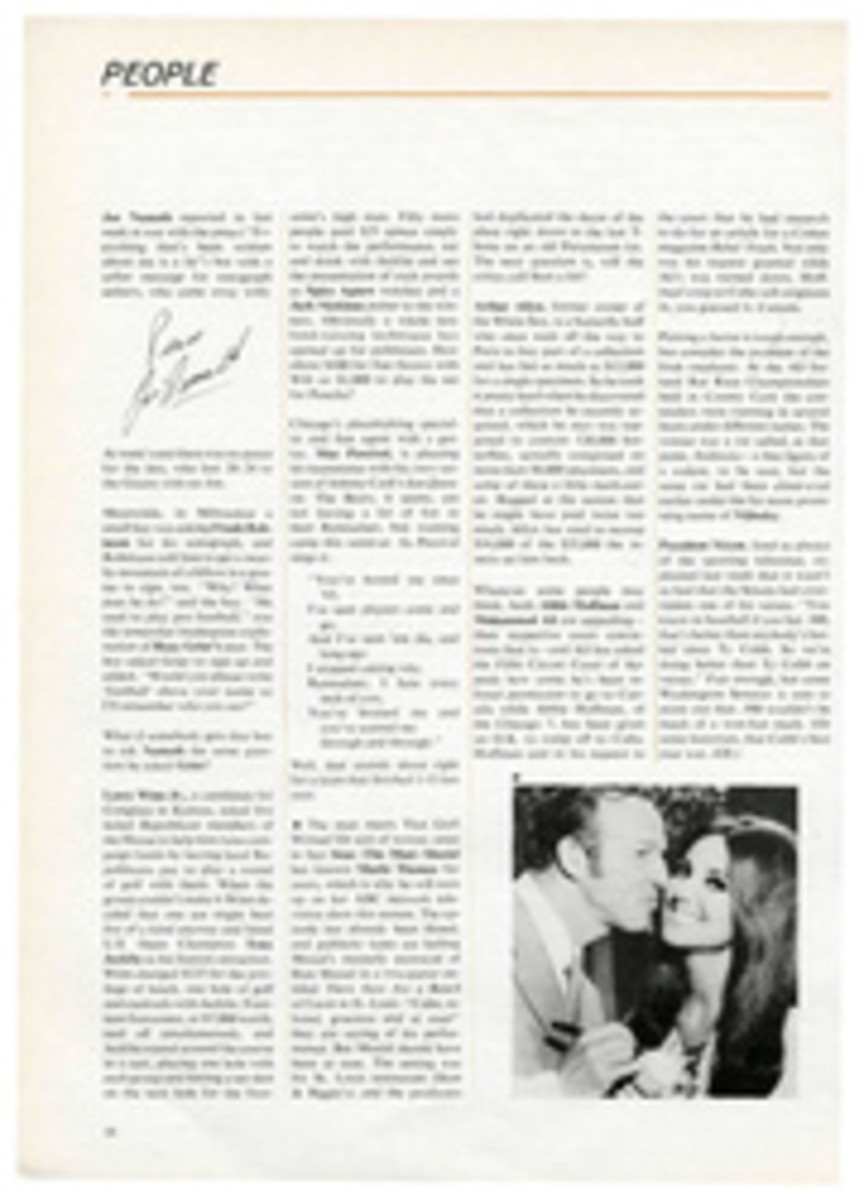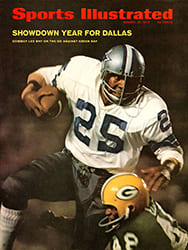
WATCH OUT! THERE ARE MORE EN ROUTE
Omar Aparicio usually works in the quiet dignity of the Chesapeake, one of Baltimore's most deluxe restaurants. His gold sommelier's chain with its key to the cellars and tasting cup dangling around his neck, Aparicio will—for $60—uncork a bottle of his favorite vintage, Chateau Lafite Rothschild 1959. But Aparicio, whose cousin Luis is the All-Star shortstop of the White Sox, has another place of business, and there the wines are less costly although the crowd is every bit as elite. He is the Orioles' team sommelier, a nonpaying job that rates a listing in the club's guide on the same page with Board Chairman Jerry Hoffberger. His duties of opening the champagne (at the party for clinching the American League's Eastern Division title last year it was undated Christian Brothers at $72 a case) for Oriole victory celebrations kept him busy in the vintage years of 1966, when Baltimore won the world championship, and 1969, when the team took another pennant.
Again this fall Aparicio is looking forward to a popping time. The Orioles are still the best team in the American League, and perhaps in all of baseball. Baltimore's familiar superstars. Brooks and Frank Robinson and Boog Powell, remain but they have had to share the glory with three superb pitchers who should win well over 20 games each and with a scouting and farm system that could extend Aparicio's stewardship for years. Some of the new faces are already forcing their way into the Orioles' lineup and others are ripening under careful supervision in vineyards at Rochester, N.Y. and elsewhere.
Baltimore's once-set outfield of Frank Robinson, Paul Blair and Don Buford is being broken apart by second-year major-leaguer Merv Rettenmund, who has been the team's best hitter during the past six weeks. Outfielder Curt Motton, who hit over .300 last year and is doing as well in his few starts this season, remains on the bench along with 23-year-old rookie Terry Crowley—the club's only new player, who had to hit .370 and play both the outfield and first base in spring training to make the team. That left Don Baylor, Roger Freed and Tom Shopay, a player pirated from the Yankees, to play the outfield in Rochester, where they have batted over .320 for the year. Until recently none of them led the Red Wings in hitting because In-fielder Bobby Grich had the top average in the International League. Grich was called to Baltimore last month to substitute occasionally in the infield for Brooks Robinson, Shortstop Mark Belanger and Second Baseman Dave Johnson, but his chances since arriving in the majors have been few. The utility man already there, Chico Salmon, is batting .308. And there are other infielders waiting in Rochester, among them Enzo Hernandez, described by Personnel Director Harry Dalton as a pup out of Aparicio, Luis—not Omar.
The Orioles' talent runs thick on their five teams lower than Triple-A Rochester. Two of those affiliates lead their leagues and another is a close second. Over the past 10 years, while Baltimore was winning more games than any team in the league, its farm clubs were winning more games than those belonging to any major league organization. Such strength has allowed Dalton to restrict his trading to a few very favorable deals. He concluded the negotiations begun by his predecessors that brought Frank Robinson—and a World Series victory—to Baltimore, and last year he traded Curt Blefary, a platooned player, to the Astros for Mike Cuellar. Cuellar won 23 games in 1969 to share the Cy Young Award with Denny McLain.
Cuellar could win the prize again this year, but if he does he probably will have to share it with teammates Dave McNally and Jim Palmer. At the end of last week McNally, the redheaded Montanan with the Huckleberry Finn face and the classic mix of a hard fastball and a sharp curveball, was 19-7. Tall, lean Palmer, easily the fastest and least controlled of the three, stood at 17-7, while Cuellar, the sinister-appearing Cuban with fine control and the trickiest screwball since Carl Hubbell, had won 19 and lost seven.
"It would be a lot easier to come to play against these three guys if they were all hard fastball pitchers like Palmer," says Ken McMullen of the California Angels. "By the third day you might have your timing down. But it doesn't work that way here. McNally's got that great curve he can throw anytime and Cuellar's screwball is a pitch nobody else in baseball throws, and he can change speeds on it."
Until recently, as fast as the farm system could turn out good young pitchers, they invariably came up with sore arms, most of them permanently damaged. Only McNally, who opened the World Series for the Orioles in 1966 but was reduced to a part-time starter in 1967, and Palmer, who as a 20-year-old was the Orioles' biggest winner in 1966, recovered. Palmer's first attempts at a comeback after tendonitis in his right shoulder struck him down the next year were so pathetic that no team was willing to take him for the $25,000 waiver price.
The pattern of sore arms stopped abruptly with the appointment as pitching coach in 1968 of George Bamberger, who, like Manager Earl Weaver and the other coaches, came up in the Orioles' minor league system. McNally and Palmer each credit him with keeping the staff healthy by making the pitchers exercise properly. "If you're in good condition, you're less apt to get hurt. It's that plain," says Bamberger.
The only place where the Orioles show any weakness is in the bullpen. Eddie Watt and Pete Richert, who were very effective last year, have been renamed Smash and Crash for their erratic work this season. But Baltimore's substitute players could be called Smash and Crash, too, for positive reasons. The bench has driven in the winning run in one of every four Oriole victories. Rettenmund, who has been hitting .393 since July 8 to raise his season's average to .312 and has become a starter, had plenty of help from his former benchmates last week as the Orioles opened up a 10½-game lead over second-place New York. Salmon hit a two-run homer as Baltimore began the week with a 3-2 victory over the Brewers. Rettenmund's homer was the winning run the next night, and he and Salmon each drove in a run the following evening when the Orioles again won 3-2.
On Friday, Crowley substituted for the injured Powell. He had two hits in three times at bat and scored two runs, the second after he singled to rightfield, stole second and advanced to third on a grounder. Angel Catcher Tom Egan allowed a pitch to roll past him a short distance and Crowley dashed home just ahead of Egan's lunging tag. Sunday, Grich hit two singles in a rare start and Motton added a two-run homer.
Aggressive play like that might impress the manager of a fourth-place team, but under Weaver it usually means that the star will be back in the next day.
"We're winning, that's the only good thing about sitting on the bench here," said Motton. "It's a little easier to take because you know we're gonna make some extra money in the playoffs and the Series at the end of the year."
The man mostly responsible for the Oriole system is Jim McLaughlin, who was the only member of the front office to transfer with the team when it moved to Baltimore from St. Louis in 1954. It was he who hired the inexperienced Dalton fresh out of the Air Force after graduating from Amherst, and it was he who, during a brief stay with the Cincinnati Reds, signed Johnny Bench, Wayne Simpson, Bernie Carbo and Hal McRae, all of whom have played important roles in the Reds' season-long pennant drive. Back with the Orioles as head of minor league business operations, McLaughlin attributes the team's success to group scouting. "We don't just use scouts to double-check each other." he says, "but we send each out with a definite purpose. I remember when we signed Powell, we had four scouts there, each with a different job."
The Powell signing was typical of Baltimore's thoroughness. Almost every team in the majors wanted him until the end of his senior year in high school when he played in a state tournament and failed to hit. Only the Orioles and one other team remained interested.
"We never hesitated," says McLaughlin. "He just had a bad series like any player. We never doubted that he was a good prospect."
Rettenmund, the best new product of the system, is also one of its more surprised recruits. "I didn't contribute to a single one of the 109 games we won last season," he said last week. "Then on top of that I had an awful winter in the Puerto Rican league. I hit .146. I began to question my ability to play in the big leagues."
Rettenmund changed his stance slightly in spring training, and when Blair was injured by a pitched ball he got his chance to play regularly. He has rarely been out of the lineup since.
"I still don't consider myself anything but a utility outfielder," Rettenmund says. With utilitymen like Rettenmund around, Omar Aparicio can begin to dream of wearing his new tailcoat. It was made specially for last year's World Series cork popping, which never came off. Aparicio, in fact, might one day have to sew leather patches on the elbows. That or buy a new tailcoat with his champagne earnings.
PHOTO
Only rookie to make Orioles this spring. Terry Crowley scores in a chance with regulars.

